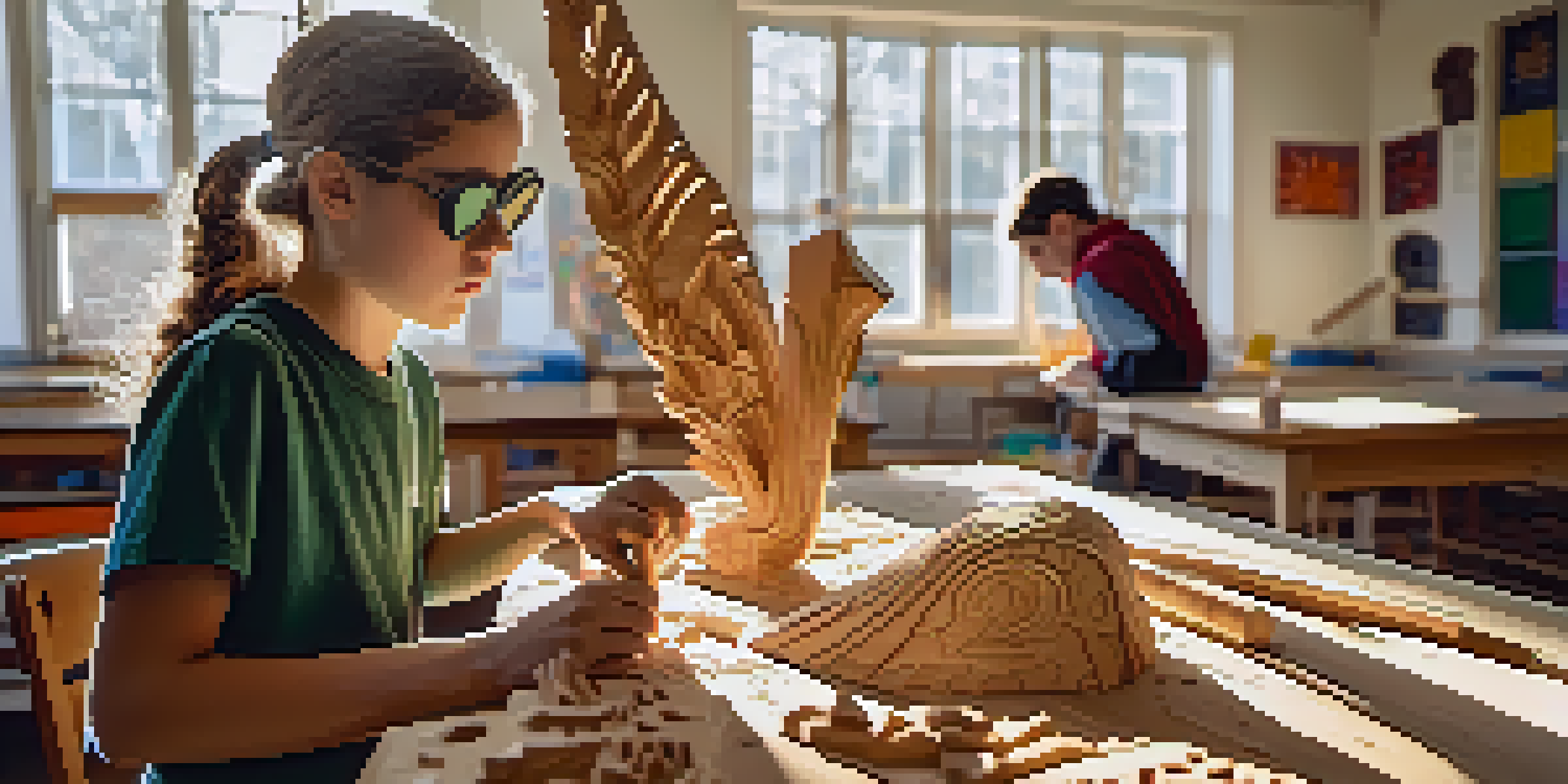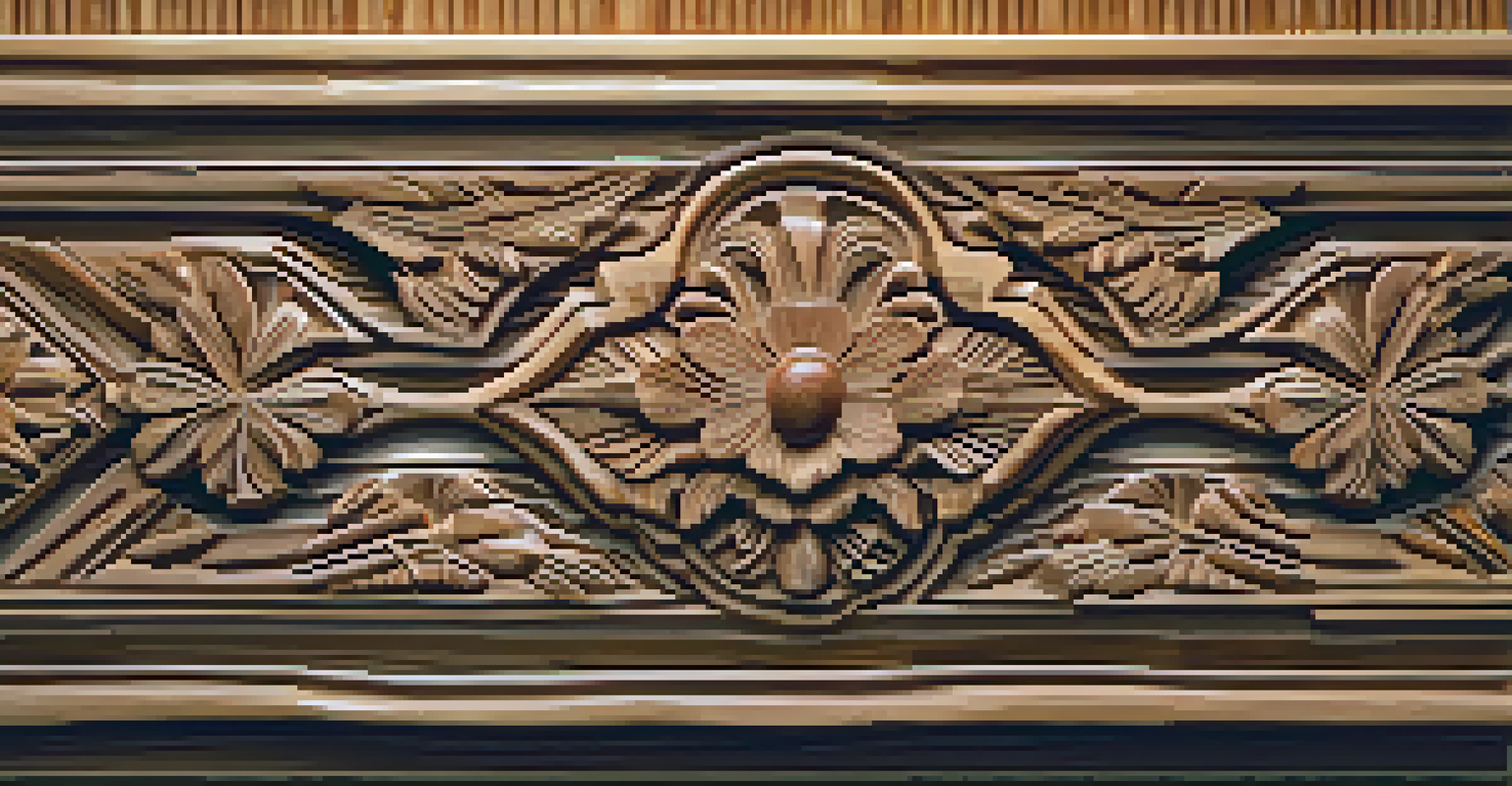The Impact of Carving on Creativity in Middle School Students

Understanding the Art of Carving
Carving is an ancient art form that involves shaping materials like wood, stone, or even soap. It allows students to engage their hands and minds in a creative process that transforms a simple block into a piece of art. This tactile experience is crucial for middle school students, as it helps them develop fine motor skills and spatial awareness.
Art is not freedom from discipline, but disciplined freedom.
Through carving, students can express their individuality and explore their artistic inclinations. Unlike digital art forms, carving requires a direct connection with the material, fostering a deeper sense of accomplishment. This hands-on approach also instills patience and perseverance, as students learn to refine their techniques over time.
Moreover, carving can serve as a therapeutic outlet for young minds, helping them to focus and relieve stress. In a world filled with distractions, the meditative nature of carving encourages mindfulness and creativity, allowing students to escape into their artistic visions.
Boosting Problem-Solving Skills Through Carving
Engaging in carving challenges students to think critically and solve problems creatively. Each piece requires planning, from selecting the right tools to envisioning the final product. This process fosters analytical thinking, as students must anticipate and navigate potential issues that may arise during their work.

For instance, when a student encounters a stubborn knot in the wood, they must consider alternative approaches to achieve their desired outcome. This not only enhances their problem-solving skills but also builds resilience and adaptability—qualities that will serve them well beyond the art classroom.
Carving Enhances Motor Skills
Carving helps middle school students develop fine motor skills and spatial awareness through hands-on engagement.
Additionally, the iterative nature of carving promotes a growth mindset. Students learn that mistakes are part of the creative journey, encouraging them to view challenges as opportunities for learning rather than setbacks.
Fostering Teamwork and Collaboration
Carving projects can be conducted individually, but they often shine in collaborative settings. When students work together on a carving project, they learn to communicate their ideas and share responsibilities. This teamwork fosters a sense of community and belonging, essential for middle schoolers navigating social dynamics.
Every artist was first an amateur.
For instance, students can create a large sculpture as a class, each contributing their unique skills and perspectives. This not only enhances their social skills but also teaches them the importance of compromise and collective creativity. They learn that diverse ideas can lead to richer, more innovative outcomes.
Moreover, collaboration in carving encourages mentorship among peers. More experienced students can guide those who are newer to the craft, fostering a supportive environment that nurtures everyone's growth.
Inspiring Self-Expression and Personal Identity
Carving provides a unique avenue for middle school students to explore their identities and express their feelings. Each piece they create can reflect their thoughts, interests, and experiences, allowing for a deeper connection to their work. This self-expression is crucial during a time when many are seeking to understand who they are.
As students carve, they often draw inspiration from their personal narratives, cultural backgrounds, or even current events. This process encourages them to articulate their viewpoints and values through their art, fostering a sense of pride in their creations.
Fosters Creativity and Self-Expression
Through carving, students express their individuality and explore their identities, reflecting their thoughts and experiences in their art.
Furthermore, the act of sharing their work with others can boost their confidence and self-esteem. Showcasing their carving can lead to positive feedback, helping them feel validated and encouraging them to continue exploring their artistic voice.
Enhancing Focus and Concentration in Students
Carving requires a level of concentration that many students may struggle to achieve in a traditional classroom setting. The intricate nature of the craft demands attention to detail, encouraging students to focus on the task at hand. This heightened level of focus can translate into improved concentration in other academic areas.
As they carve, students learn to block out distractions and immerse themselves in their work. This practice can lead to increased cognitive abilities, as they train their brains to stay engaged for longer periods. The sense of accomplishment that comes from completing a carving can also enhance their motivation to focus on future tasks.
Moreover, the repetitive motions involved in carving can have a calming effect, akin to mindfulness practices. This can help students manage stress and anxiety, further improving their overall concentration and mental well-being.
Carving as a Gateway to Artistic Exploration
Carving can act as a springboard for students to explore various forms of art and creativity. Once they grasp the basics of carving, they may feel inspired to experiment with other techniques, such as painting, drawing, or even digital art. This exploration can broaden their artistic horizons and encourage lifelong creative pursuits.
For example, a student who initially finds joy in carving might discover a passion for sculpting or pottery after experiencing the satisfaction of creating something tangible. This newfound interest can lead to a deeper appreciation for the arts and a desire to pursue related subjects in school.
Encourages Teamwork and Collaboration
Collaborative carving projects teach students the importance of communication, compromise, and mentorship among peers.
Additionally, exposure to different artistic styles can foster a more well-rounded education. Students who engage in various forms of art may develop a richer understanding of culture, history, and human expression.
Encouraging a Lifelong Passion for Creativity
The skills and experiences gained through carving can instill a lifelong passion for creativity in students. As they discover the joy of creating with their hands, they may continue to seek out artistic opportunities throughout their lives. This passion can lead to a fulfilling hobby or even a career in the arts.
Moreover, the confidence gained from mastering carving techniques can empower students to pursue other interests and challenges. They learn that creativity is not limited to art but can be applied in various fields such as science, technology, and entrepreneurship.

Ultimately, fostering creativity in middle school students through carving can lead to well-rounded individuals who appreciate the value of self-expression and innovative thinking in all aspects of life.